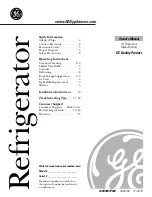
12
The lights do not work
■
Is the power supply cord unplugged? Plug into a grounded
3 prong outlet.
■
Is a light bulb loose in the socket or burned out? See
“Changing the Light Bulb.”
There is water in the defrost drain pan
■
Is the refrigerator defrosting? The water will evaporate. It is
normal for water to drip into the defrost pan.
■
Is it more humid than normal? Expect that the water in the
defrost pan will take longer to evaporate. This is normal when
it is hot or humid.
The motor seems to run too much
■
Is the room temperature hotter than normal? Expect the
motor to run longer under warm conditions. At normal room
temperatures, expect your motor to run about 40% to 80% of
the time. Under warmer conditions, expect it to run even more
of the time.
■
Has a large amount of food just been added to the
refrigerator? Adding a large amount of food warms the
refrigerator. It is normal for the motor to run longer in order to
cool the refrigerator back down. See “Refrigerator Features.”
■
Is the door opened often? Expect the motor to run longer
when this occurs. In order to conserve energy, try to get
everything you need out of the refrigerator at once, keep food
organized so it is easy to find, and close the door as soon as
the food is removed.
■
Is the control set correctly for the surrounding conditions?
See to “Using the Control.”
■
Is the door closed completely? Push the door firmly shut. If
it will not shut all the way, see “The door is difficult to open or
will not close completely” later in this section.
■
Are the condenser coils dirty? This blocks air transfer and
makes the motor work harder. Clean the condenser coils. See
“Refrigerator Care.”
NOTE: Due to its high-efficiency motor, your new refrigerator will
run longer than your old one.
The refrigerator seems to make too much noise
■
The sounds may be normal for your refrigerator.
See “Normal Sounds.”
Temperature is too warm
■
Are the air vents blocked? Remove any objects from in front
of the air vents. See “Ensuring Proper Air Circulation” for the
location of air vents.
■
Is the door opened often? Be aware that the refrigerator will
warm when this occurs. To keep the refrigerator cool, try to
get everything you need out of the refrigerator at once, keep
food organized so it is easy to find, and close the door as
soon as the food is removed.
■
Has a large amount of food just been added to the
refrigerator? Adding a large amount of food warms the
refrigerator. It can take several hours for the refrigerator to
return to the normal temperature.
■
Is the control set correctly for the surrounding conditions?
See “Using the Control.”
There is interior moisture buildup
■
Are the air vents blocked in the refrigerator? Remove any
objects from in front of the air vents. See “Ensuring Proper Air
Circulation” for the location of air vents.
■
Is the door opened often? To avoid humidity buildup, try to
get everything you need out of the refrigerator at once, keep
food organized so it is easy to find, and close the door as
soon as the food is removed. (When the door is opened,
humidity from the room air enters the refrigerator. The more
often the door is opened, the faster humidity builds up,
especially when the room itself is very humid.)
■
Is the room humid? It is normal for moisture to build up
inside the refrigerator when the room air is humid.
■
Is the food packaged correctly? Check that all food is
securely wrapped. If necessary, repackage food according to
the guidelines in “Refrigerator Features.” Wipe off damp food
containers before placing in the refrigerator.
■
Is the control set correctly for the surrounding conditions?
See “Using the Control.”
■
Was a self-defrost cycle completed? It is normal for
droplets to form on the back wall after the refrigerator self-
defrosts.
The door is difficult to open or will not close completely
■
Are the gaskets dirty or sticky? Clean gaskets according to
the directions in “Refrigerator Care.”
■
Are food packages blocking the door open? Rearrange
containers so that they fit more tightly and take up less space.
■
Are the crisper cover, pans, shelves, bins, or baskets out
of position? Put the crisper cover and all pans, shelves, bins,
and baskets back into their correct positions. See
“Refrigerator Features” for more information.
■
Does the refrigerator wobble or seem unstable? Level the
refrigerator. See “Adjust the Door.”
Electrical Shock Hazard
Plug into a grounded 3 prong outlet.
Do not remove ground prong.
Do not use an adapter.
Do not use an extension cord.
Failure to follow these instructions can result in death,
fire, or electrical shock.
WARNING
WARNING
Explosion Hazard
Use nonflammable cleaner.
Failure to do so can result in death, explosion, or fire.













































